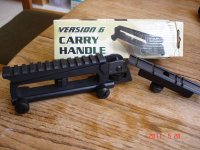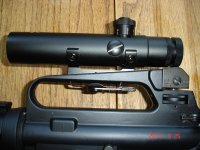Easier to show a photo. Recoil was stout and easily double that of a 5.56/.223. I have a SlideFire stock and along with the 7.62/.308 recoil, the muzzle would climb. I added a LaRue SJC Titan Compensator, which greatly reduced recoil and eliminated muzzle climb. I do not use the SlideFire that much, just occasionally. I realize there is extra wear and tear on the rifle, when using the SlideFire. I use the SlideFire mostly on my 15/22, and sometimes on my 15T, but only limited use on all my rifles..
The scope is a UTG Compact CQB Bug Buster 3x9, which has 3-4 inches of eye relief. For an inexpensive scope, it has excellent optics, and great features, and takes the abuse of the recoil. It retains zero, even after using the SlideFire. Between the scope, red dot, and laser, plus the risers, I have added a little over 2 pounds to the AR10. I have a 1 inch triple picatinny riser, and then a v-riser mounted on that. All were cut shorter, to eliminate excess weight. Balance is a little top heavy, but not too much, as the bare AR10 weighs 8.5 pounds, with no magazine. It is now 10.8 pounds, and 12 pounds with a full mag. You don't shoot this rifle like an AR15, with the high mount on the shoulder. You want and need full contact with the shoulder, so that is the reason the scope and red dot are about 2 inches above the flat top rail. The weight and compensator help reduce a lot of the felt recoil.
Scope is zeroed to 200 yards and the red dot and BUIS at 100. I compensate for shorter distances with the red dot, and the scope has a mil-dot reticule. The rear sight, for the BUIS, is welded into the v-riser. The front sight is a flip up sight, mounted to the picatinny rail, on the gas block.
Bob



5.56 compared to 7.62









